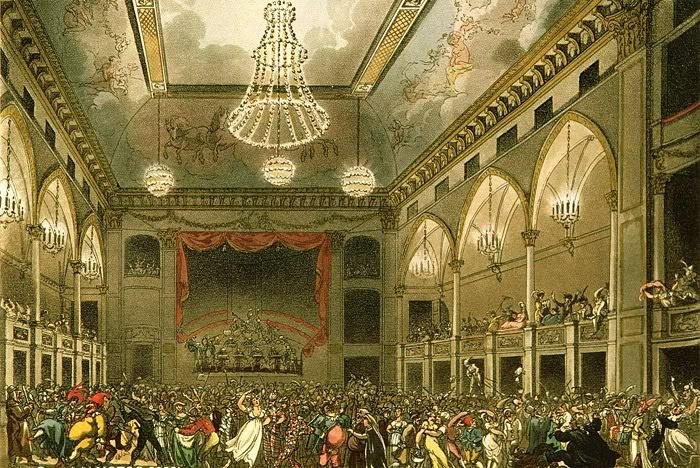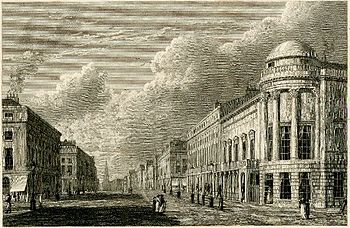
“At the corner of Little Argyll Street formerly stood the Argyll Rooms. The establishment was founded under the auspices of Colonel Greville, a noted sportsman and “man about town” under the Regency, who purchased a large house and turned it into a place of entertainment, as a rival to the Pantheon. The fashionable world worshipped at Colonel Greville’s shrine, and its balls, masquerades, and amateur balls soon became part of the recognised amusements of West-end society.
In 1811 Lady Margaret Crawford, a lady of eccentric and individual character, gave a ball here “to all her friends, or rather her enemies.” It is made a matter of complaint by a French gentleman of fashion in London, in 1823, addressing an English friend, “The wives and daughters of your most respectable country gentlemen no sooner arrive in London than, forgetting all high feelings of conscious virtue and hereditary pride, they seem anxious to purchase, at any price, the honour of belonging to ‘The Argyll Street Rooms,’ and of frequenting the Wednesday balls at ‘Almack’s.’ Even mothers of families, who have gone through life with untainted reputation, if unable to gain the envied distinction themselves, will condescend to court the ‘patronage’ of women of very different characters, and to entrust their fair young daughters to the care of peeresses, whose ‘indiscretions’ would long since have banished them from all association with the best of their own sex, had not their lords been conveniently blind to their failings. No costs or pains are spared to propitiate these deities of fashion—the ‘lady patronesses.'”
In 1818 the rooms were rebuilt in a handsome style, by Mr. John Nash, the architect. Here the contralto singer, Velluti, gave a concert in June, 1829. In the same year, M. Chabert, who rejoiced in the title of the “fire king,” here exhibited his power of resisting the effects of poisons, and withstanding extreme heat. Among other things, we are told that he “swallowed forty grains of phosphorus, sipped oil at 333° with impunity, and rubbed a red-hot shovel over his tongue, hair, and face unharmed; that he swallowed a piece of a burning torch; and then, dressed in coarse woollen, entered an oven heated to 380°, sung a song, and cooked two dishes of beef-steaks!” “These performances,” it is added, “were suspected of being a chemical juggle.”
The building was burnt down in 1830. On this occasion, Mr. Braithwaite first publicly applied steam-power to the working of a fire-engine; and we are informed that “it required eighteen minutes to raise the water in the boiler to 212°, when the engine threw up from thirty to forty tons of water per hour to a height of ninety feet.“( http://www.british-history.ac.uk/old-new-london/vol4/pp235-246)

The Argyll Rooms were indeed a haunt of the haute ton. Originally opened in 1806 by Colonel Henry Greville, management was turned over to Stephen Slade in 1812 who, in turn, sold it to The Regent Street Commissioners in 1819. In 1820 it would be reopened as a music shop and concert hall, becoming one of the more fashionable places to see concerts.
Greville, who was a sexy scapegrace (very handsome, but very bad with money), had initially started the venture as a “theatrical fete and supper” for his friends, whereby the supper was more of a potluck (or what was called in the Regency a picnic). It was such a successful event they decided to form a Pic-Nic Society the following year, in 1802. The Pic-Nics used a location in Tottenham Street, but the venture only lasted a year before it was derided (http://www.british-history.ac.uk/survey-london/vols31-2/pt2/pp284-307#h3-0014). He then went on to acquire the Argyll Rooms and convert the house for public entertainment.
Balls at the Rooms were considered as “particularly splendid” as those at Almack’s and “numerously attended by the fashionable room” (Pursuit of Pleasure: Gender, Space and Architecture in Regency London, 2010, p. 89). It appears its success as a ballroom was, however, shortlived:
(A Dictionary of Music and Musicians: (A.D. 1450-1889), 1890)
 Tickets to balls and concerts at Argyll Rooms from 1806-1812 were available only to subscribers, very similar to Almacks. Tickets were 10s each, but an attendee needed a voucher from a patroness to gain admission. In 1806, “two dukes and a list of ladies from the upper nobility, including Lady Jersey, controlled admission” (Fashionable Acts: Opera and Elite Culture in London, 1780-1880, 2007, p. 123)
Tickets to balls and concerts at Argyll Rooms from 1806-1812 were available only to subscribers, very similar to Almacks. Tickets were 10s each, but an attendee needed a voucher from a patroness to gain admission. In 1806, “two dukes and a list of ladies from the upper nobility, including Lady Jersey, controlled admission” (Fashionable Acts: Opera and Elite Culture in London, 1780-1880, 2007, p. 123)
In July 1813, a ball was held here by four leading dandies of the day, Brummell, Alvanley, Pierrepoint and Mildmay, to celebrate (The London Encyclopaedia, 2011) considerable gambling winnings at hazard (Blackwood’s Edinburgh Magazine, 1844). The Prince, still stinging from his cut from Brummel on St. James, delivered Brummel the cut direct at the Rooms, solidifying its moment in history (Blackwood’s Edinburgh Magazine, 1844).
Concerts, masquerades, balls and other events would continue, even after the demolition and rebuilding of the rooms around 1820 until 1830, when a fire broke out and destroyed the building. The Philharmonic would move on to King’s Theatre, and eventually the Argyll Rooms fell into disuse until it was reappropriated as shops.
Lord Byron satirized Argyll Room fashion in this passage of the English Bards and Scotch Reviewers (1809):
Or hail at once the patron and the pile
Of vice and folly, Greville and Argyle!
Where yon proud palace, Fashion’s hallowed fane,
Spreads wide her portals for the motley train,
Behold the new Petronius of the day,
Our arbiter of pleasure and of play!
There the hired eunuch, the Hesperian choir,
The melting lute, the soft lascivious lyre,
The song from Italy, the step from France,
The midnight orgy, and the mazy dance,
The smile of beauty, and the flush of wine,
For fops, fools, gamesters, knaves, and Lords combine:
Each to his humour—Comus all allows;
Champaign, dice, music, or your neighbour’s spouse.
Here is a description of the rooms from its hey-day (Leigh’s new picture of London, 1818):
For a description of the rooms: http://www.british-history.ac.uk/survey-london/vols31-2/pt2/pp284-307#h3-0014









